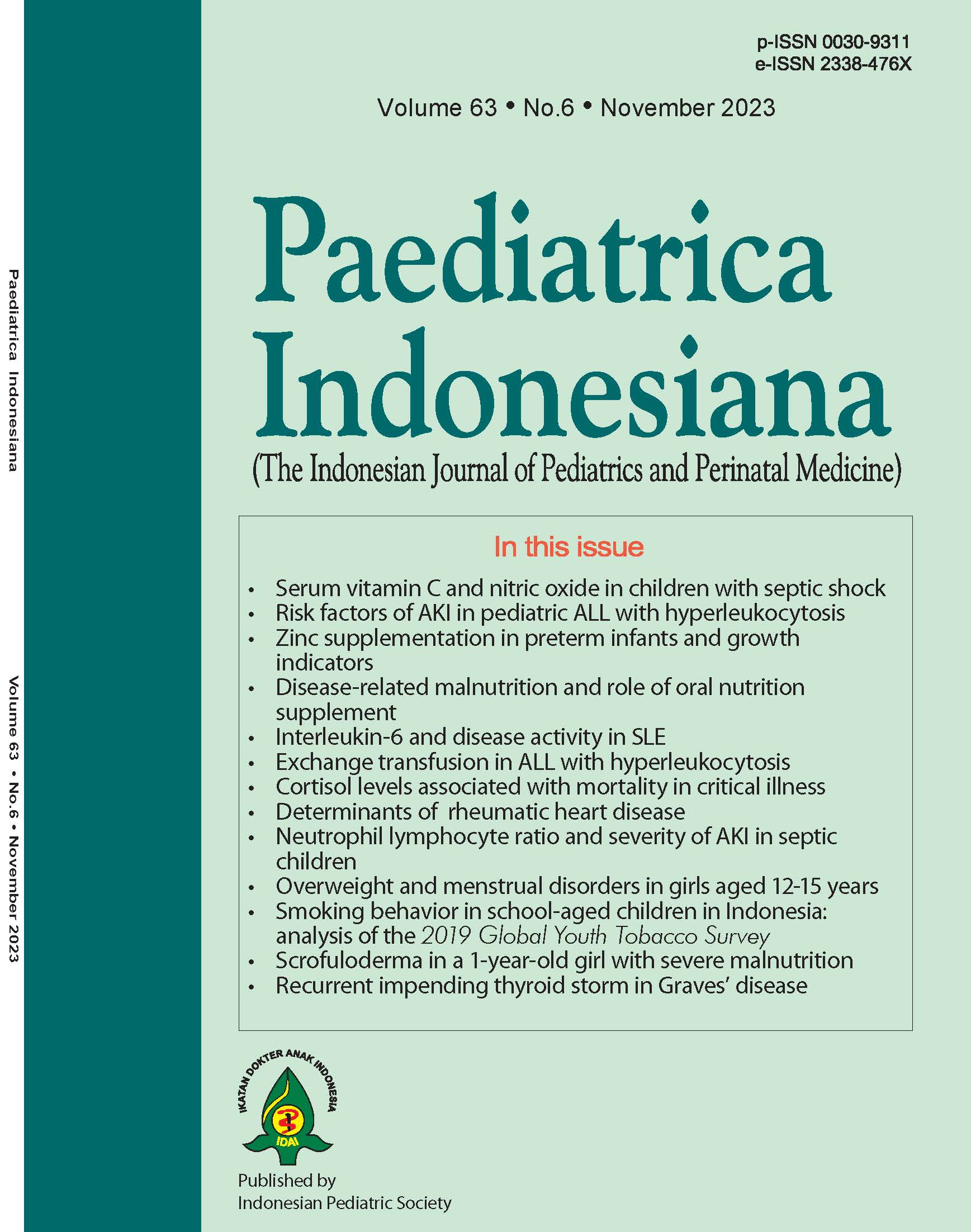Scrofuloderma in a 1-year-old girl with severe malnutrition: a case report
DOI:
https://doi.org/10.14238/pi63.6.2023.511-6Keywords:
tuberculosis, cutaneous, scrofuloderma, children, extrapulmonaryAbstract
Tuberculosis (TB) remains a global burden and a leading cause of mortality due to infectious diseases worldwide. In 2020, 845,000 new TB cases (312 per 100,000 population) were diagnosed, with 96,000 deaths, including 4,700 deaths of TB with HIV. Tuberculosis typically affects the lungs, but it can also affect other organs, a condition termed extrapulmonary TB. In 2020, 16% of all TB cases had extrapulmonary manifestations.1 The first case of TB affecting the skin was reported in 1826.2,3 There are many types of cutaneous TB; one of the most common is scrofuloderma, more often found in children and young adults.4 Scrofuloderma starts with a lesion in a lymph node, bone, muscle, or tendon that spreads to the skin.5 The lesion progresses very slowly and is usually not painful. Therefore, many patients wait to seek treatment until an advanced stage, leading to poor prognosis.3 In this report, we present a case of a severely malnourished one-year-old girl with scrofuloderma.
References
2. Vashisht P, Sahoo B, Khurana N, Reddy BSN. Cutaneous tuberculosis in children and adolescents: a clinicohistological study. J Eur Acad Dermatol Venereol. 2007;21:40-7. DOI: https://doi.org/10.1111/j.1468-3083.2006.01858.x.
3. Cantres-Fonseca OJ, Rodriguez-Cintrón W, Olmo-Arroyo FD, Baez-Corujo S. Extrapulmonary tuberculosis: an overview. In: Chauhan NS, editor. Role of microbes in human health and diseases. London: InTechOpen; 2018. DOI: https://doi.org/10.5772/intechopen.81322.
4. Malavia G, Parikh R, Bhate A. A rare case of scrofuloderma. SSRG – Int J Med Scien. 2017;4:12-14. DOI: https://doi.org/10.14445/23939117/IJMS-V4I8P104.
5. Kim GW, Park HJ, Kim HS, Kim SH, Ko HC, Kim BS, et al. Delayed diagnosis of scrofuloderma misdiagnosed as a bacterial abscess. Ann Dermatol. 2012;24:70-3. DOI: https://doi.org/10.5021/ad.2012.24.1.70.
6. Kementerian Kesehatan Republik Indonesia. Petunjuk teknis manajemen dan tatalaksana tuberkulosis anak. Jakarta: Kementerian Kesehatan Republik Indonesia; 2016.
7. World Health Organization. Guidance for national tuberculosis programmes on the management of tuberculosis in children. 2nd ed. Geneva: World Health Organization; 2014.
8. Unit Kelompok Kerja Respirologi Ikatan Dokter Anak Indonesia. Tuberkulosis dengan keadaan khusus, in: Pedoman nasional tuberkulosis anak. 2nd edition with revision. Jakarta: UKK Respirologi PP IDAI; 2008. p. 71-2.
9. World Health Organization. Implementing the WHO stop TB strategy. Geneva: World Health Organization; 2008.
10. Soeroso NN, Harina EG, Yosi A. A very rare case of scrofuloderma with multiple cervical lymphadenitis tuberculosis. Respir Med Case Rep. 2019;27:1-3. DOI: https://doi.org/10.1016/j.rmcr.2019.100842.
11. Khadka P, Koirala S, Thapaliya J. Cutaneous tuberculosis: Clinicopathologic arrays and diagnostic challenges. Dermatol Res Pract. 2018;2018:72019973. DOI: https://doi.org/10.1155/2018/7201973.
12. Tadele H. Scrofuloderma with disseminated tuberculosis in an Ethiopian child: a case report. J Med Case Reports. 2018;12:371. DOI: https://doi.org/10.1186/s13256-018-1927-1
13. Djuanda A, Hamzah M, Aisah S. Ilmu kesehatan kulit dan kelamin. Jakarta: Fakultas Kedokteran Universitas Indonesia; 2007.
14. . Bagherirad M, Athan E, Harris OC. Forgotten but not gone - scrofuloderma in a migrant student from India. Australas Med J. 2013;6:371–3. DOI: https://doi.org/10.21767/AMJ.2013.1759.
15. Dos Santos JB, Figueiredo AR, Ferraz CE, de Oliveira MH, da Silva PG, de Medeiros VLS. Cutaneous tuberculosis: diagnosis, histopathology and treatment - Part II. An Bras Dermatol. 2014;89:545–55. DOI: https://doi.org/10.1590/abd1806-4841.20142747
16. Nursyamsi HS, Rasjid M. TBC dengan tes mantoux di bagian ilmu kesehatan anak RSU Prof. DR.R.D.Kandou Manado periode 2001-2006. Inspirasi. 2011;1:65-90.
17. Marianto, Kosim H, Mahariski PA, Christopher PM. Update on scrofuloderma. Bali Dermatol Venereol J. 2019;2:34-41. DOI: https://doi.org/10.15562/bdv.v2i2.20
18. Ramirez-Lapausa M, Menendez-Saldana A, Noguerado-Asensio A. Extrapulmonary tuberculosis: an overview. Rev Esp Sanid Penit. 2015;17:3-11. PMID: 16300038.
19. Nurman J, Darmawan BS. Skrofuloderma pada anak: Penyakit yang terlupakan? Sari Pediatri. 2010;12:108-15. DOI: https://doi.org/10.14238/sp12.2.2010.108-15.
20. Amar T, Patel Z, Rewat M. Scrofuloderma: a rare case report on cutaneous tuberculosis. Clin Med Rev Case Rep. 2020;7:330. DOI: https://doi.org/10.23937/2378-3656/1410330.
21. Bleeker-Rovers CP, De Vries HJC. Dermatologic manifestations of systemic infections. In: Cohen J, Powderly WG, Opal SM, editors. Infectious diseases. 4th ed. Amsterdam: Elsevier; 2017. p. 113-21. DOI: https://doi.org/10.1016/B978-0-323-04579-7.00012-5.
Downloads
Published
How to Cite
Issue
Section
License
Authors who publish with this journal agree to the following terms:
Authors retain copyright and grant the journal right of first publication with the work simultaneously licensed under a Creative Commons Attribution License that allows others to share the work with an acknowledgement of the work's authorship and initial publication in this journal.
Authors are able to enter into separate, additional contractual arrangements for the non-exclusive distribution of the journal's published version of the work (e.g., post it to an institutional repository or publish it in a book), with an acknowledgement of its initial publication in this journal.
Accepted 2023-12-14
Published 2023-12-14


















